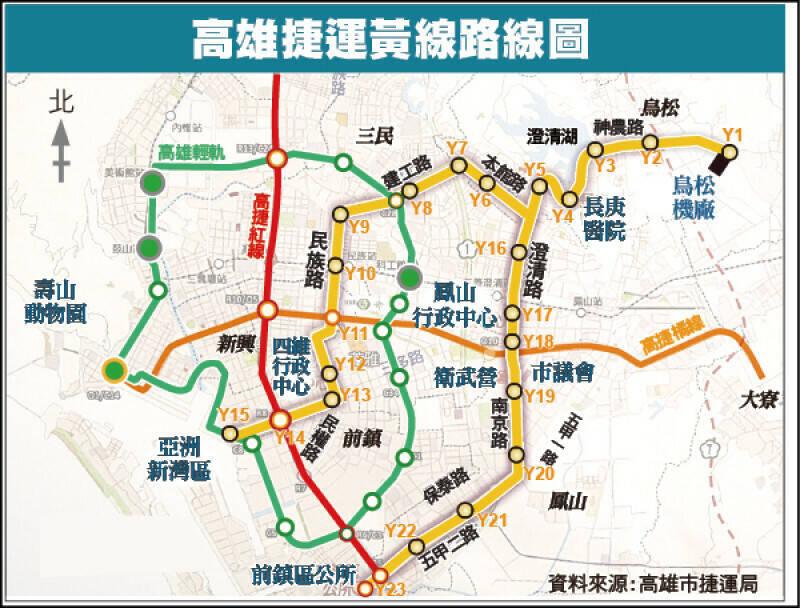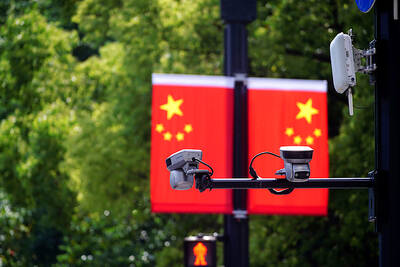The estimated completion date for the Kaohsiung MRT’s new Yellow Line has been extended to 2034, with operations to begin on some sections two years earlier in 2032, Kaohsiung Deputy Mayor Charles Lin (林欽榮) said today.
Lin was answering questions from city councilors, who asked whether the line would be finished by 2028 as originally estimated.
Material prices have pushed up the overall cost of the project 62.8 percent from NT$144 billion to NT$235 billion (US$4.42 billion to US$7.21 billion), Lin said, adding that the central government has agreed to the increased cost.

Photo copied by Wang Jung-hsiang, Taipei Times
However, due to the adjustments, the central government has asked for a delayed timeline, he added.
The line is to open in sections, starting with stations Y1 to Y5, then stations Y5 to Y18, he said.
A commuter transit line is a major infrastructure project and cannot be rushed, Lin added.

Photo courtesy of the Kaohsiung Mass Rapid Transit Bureau
Of the additional funds needed, the Kaohsiung City Government is only responsible for NT$4.03 billion, he said, adding that it is within the affordable range.
It was earlier announced that Kaohsiung would be responsible for NT$60.82 billion of the original estimated cost of NT$144 billion.
The proposed Yellow Line would connect Kaohsiung’s Red and Orange MRT lines, as well as a light-rail system and a railway station.
It is to pass through Niaosong (鳥松), Sanmin (三民), Lingya (苓雅), Sinsing (新興), Fongshan (鳳山) and Cianjhen (前鎮) districts, and serve 1.16 million people, or about 41.8 percent of the city’s population, the Kaohsiung Mass Rapid Transit Bureau said when the plan was approved in 2022.
Additional reporting by CNA

CAUTION: Based on intelligence from the nation’s security agencies, MOFA has cautioned Taiwanese travelers about heightened safety risks in China-friendly countries The Ministry of Foreign Affairs (MOFA) yesterday urged Taiwanese to be aware of their safety when traveling abroad, especially in countries that are friendly to China. China in June last year issued 22 guidelines that allow its courts to try in absentia and sentence to death so-called “diehard” Taiwanese independence activists, even though Chinese courts have no jurisdiction in Taiwan. Late last month, a senior Chinese official gave closed-door instructions to state security units to implement the guidelines in countries friendly to China, a government memo and a senior Taiwan security official said, based on information gathered by Taiwan’s intelligence agency. The

Taiwan Semiconductor Manufacturing Co (TSMC), the world’s largest contract chipmaker, said yesterday that it is looking to hire 8,000 people this year, at a time when the tech giant is expanding production capacity to maintain its lead over competitors. To attract talent, TSMC would launch a large-scale recruitment campaign on campuses across Taiwan, where a newly recruited engineer with a master’s degree could expect to receive an average salary of NT$2.2 million (US$60,912), which is much higher than the 2023 national average of NT$709,000 for those in the same category, according to government statistics. TSMC, which accounted for more than 60 percent

Tung Tzu-hsien (童子賢), a Taiwanese businessman and deputy convener of the nation’s National Climate Change Committee, said yesterday that “electrical power is national power” and nuclear energy is “very important to Taiwan.” Tung made the remarks, suggesting that his views do not align with the country’s current official policy of phasing out nuclear energy, at a forum organized by the Taiwan People’s Party titled “Challenges and Prospects of Taiwan’s AI Industry and Energy Policy.” “Taiwan is currently pursuing industries with high added- value and is developing vigorously, and this all requires electricity,” said the chairman

‘POOP ON STAGE’: The song, which talks about the reluctance to graduate and anxiety about a lack of job opportunities, resonated with many students’ feelings The original song Poop on Stage has been chosen as National Taiwan University’s (NTU) graduation song this year, sparking much debate regarding the song’s title and content, which describes students’ anxiety about post-graduation unemployment. The title, Shang Tai Da Bian (上台大便), is a play on words that literally means “go on stage to poop.” The first three characters, shang tai da (上台大), also mean “to attend NTU,” as “Taida” is a common abbreviation for the university. The last character, bian (便), can mean “convenient” or “then,” but is more commonly associated with defecation. The lyrics of the song describe students’ reluctance to graduate and